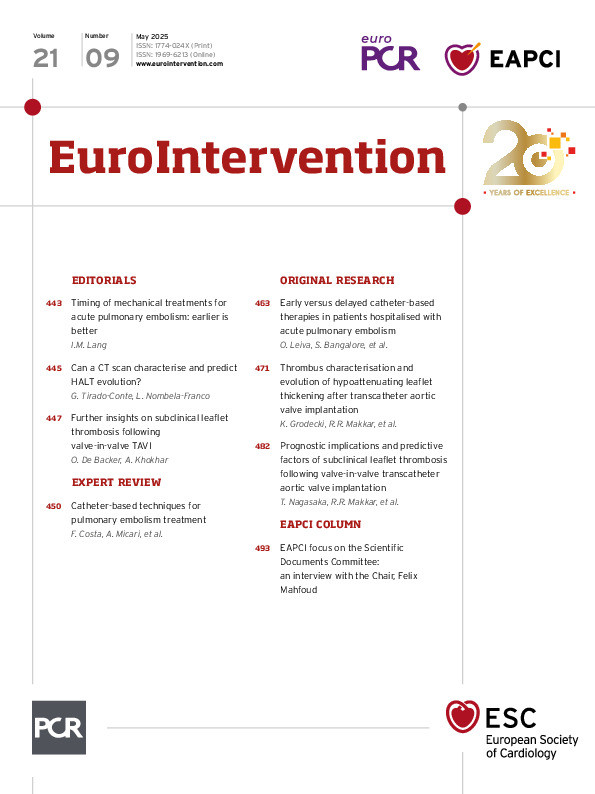Cory:
Unlock Your AI Assistant Now!
Acute vascular syndromes such as acute myocardial infarction (AMI), stroke and acute intermediate-high risk pulmonary embolism (PE) confer high mortality, particularly when they result from thrombotic occlusion of major vessels, all with similar acute mortality rates of about 20%. While historically, fibrinolytic treatments have been established based on the presence of fibrin within acute thrombi, mechanical treatments have outperformed thrombolysis in AMI, have successfully complemented stroke treatments1, and represent the way forward in the treatment of acute PE2.
In contrast to fibrinolytic treatment for both AMI and stroke, systemic thrombolysis for PE appears to have a wider therapeutic window. In single acute fatal PE cases, thrombi were found to vary from a fresh loose red clot to various histological stages of organisation3, suggesting thrombus growth over a period of time. Outside of the coronary and cerebral circulation, the pulmonary circulation is assisted by the bronchial circulation which is able to provide a collateral supply of the lung parenchyma via pulmonary artery adventitial networks and prevents lung ischaemia. However, the inverse relation between duration of symptoms and response to thrombolysis indicates that thrombolytic treatment should commence as soon as possible after acute PE is diagnosed, and is still useful in patients who have had symptoms for 6 to 14 days45. Interestingly, 6 hours after the last known well has been a meaningful threshold for initiation of thrombolysis in case of AMI, stroke and acute PE.
But does the experience with fibrinolytic treatment for acute vascular syndromes translate directly to mechanical treatments?
For AMI, scientific evidence has reset the primary percutaneous interventional treatment clock to 120 minutes after diagnosis6. Mechanical treatment has become the standard of care in patients with large vessel occlusion-related acute stroke1 with benefit of reperfusion treatment reduced by 6% per hour delay7. In the ongoing HI-PEITHO trial that is testing the safety and efficacy of ultrasound-assisted catheter-directed thrombolysis for the treatment of acute intermediate high-risk PE against standard heparin, the time from diagnosis to randomisation has been limited to a maximum of 8 hours (ClinicalTrials.gov: NCT04790370).
In this issue of EuroIntervention, Leiva et al8 investigate the optimal timing of catheter-directed therapies (CDT)9 as emerging technologies for relief of right ventricular afterload in acute PE.
In 12,137 patients with acute intermediate and high-risk PE who underwent CDT in the Nationwide Readmissions Database between January 2017 and December 2020, early CDT (≤1 day from admission) was compared with delayed (>1 day) CDT. The primary outcome was death at 90 days, and secondary outcomes included 90-day readmissions. Propensity scores were estimated using logistic regression, and propensity score weighting was utilised to compare outcomes between early and late CDT, taking into account multiple confounders such as age, sex, month of admission, year of admission, weekend admission, elective admission, history of cancer, smoking, hypertension, prior venous thromboembolism, heart failure, diabetes, coronary artery disease, chronic kidney disease, liver disease, anaemia, thrombocytopaenia, long-term anticoagulation use, long-term antiplatelet use, prior stroke, home oxygen use, chronic lung disease, do not resuscitate status, palliative care, obesity, cardiogenic shock, presence of other types of shock, use of vasopressors, deep vein thrombosis, respiratory failure during index hospitalisation, mechanical ventilation, systemic thrombolysis use, hospital size and location, insurance, and zip code median income. The data show that early CDT was associated with lower risk of 90-day death, 90-day readmission, and lower in-hospital major bleeding. While propensity matching is laudable, the gestalt and local expertise cannot be adjusted for. This is particularly relevant in the field of PE where the decision to treat is not anchored in solid trial data and involves different specialities with different thresholds to intervene.
Still, despite the study design, Leiva et al8 add to the growing support for the rule that acute vascular syndromes need timely mechanical treatments, and “earlier is better” appears to also apply to the “slowest” of the three: acute PE.
Conflict of interest statement
I.M. Lang has relationships with drug companies including AOP Health, Actelion-Janssen, Merck & Co, United Therapeutics, Pulnovo, Medtronic, Novo Nordisk, Daiichi Sankyo, and Sanofi; in addition to being an investigator in trials involving these companies, relationships include consultancy service, research grants, and membership of scientific advisory boards.

